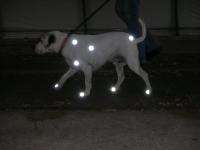Modelling virtual dogs: It's a walk in the park!

Dog walking is a national pastime, but how does your dog walk? Different breeds have different gaits, for example greyhounds tend to be thin and fast whilst labradors are thicker set and tend to waddle.
Using computers to simulate the way dogs walk, scientists at the Royal Veterinary College in London have found that fairly simple models can be used to explain the mechanics of canine locomotion.
"This technique could help us understand the mechanics behind walking problems such as hip dysplasia", says Dr Jim Usherwood who is leading this investigation and will be presenting his latest results at the Annual Meeting of the Society for Experimental Biology on Tuesday 4th April.
Dr Usherwood first made different computer models of a walking dog and then compared these with observations of actual dogs on a treadmill. He found that the way dogs walk can be explained using a surprisingly simple passive stiff-limbed model. "We already know a lot about bipedal movement; but we wanted to understand quadrupedal movement and were surprised that the mechanics involved are less complicated than we first imagined".
Usherwood was partly inspired by his colleagues David Lee and Andy Biewener at Harvard, who in collaboration with Boston Dynamics are involved in designing 4-legged robots with potential military or rescue applications.
Source: Society for Experimental Biology


















